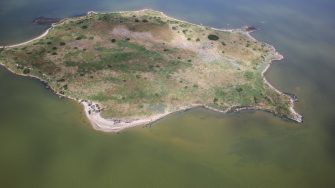
Date: Thursday, November 3, 2016
Project: Eastern Australian Waterbird Survey
Observer: Richard Kingsford
Today was delightful for aerial survey but disappointing for the waterbirds. We experienced the best conditions for aerial survey over the last couple of days, since we have surveyed the Coorong and Lower Lakes over the last nine years, beginning in 2007. It was a stunning morning, starting at daybreak and flying down past the Murray Mouth.
Daybreak loading up the plane at Goolwa
Surveying the Murray mouth, early in the morning
It was very soon obvious that the tens of thousands of waterbirds that we had become used to on the Lower Lakes and the Coorong over the past nine years were not here. Our preliminary estimates were that less than a tenth of the long-term average numbers of waterbirds were on this internationally important wetland.
The Coorong usually ‘heaved’ with grey teal, shelduck, terns, migratory shorebirds and banded stilts. But only a smattering greeted us this morning. Terry, counting on the open water side where the birds are always fewer, at one point almost went on strike because he got bored. The edge of the wetland, where I was, was reasonably busy but nothing like the ‘usual busy’.
We do like seeing waterbirds but the disappointment was more than offset by the beauty and the knowledge that most of the waterbirds we usually count were busily breeding on the hundreds of thousands of hectares of wetlands we had already surveyed. The other obvious difference was that the Coorong was ‘fuller’ than we had seen it in the last nine years, extending right down to its most extreme southern end.
Early morning surveying on the Coorong
The other major difference – waterbirds were breeding everywhere we surveyed. There were lots of broods of swans and mountain ducks – we can see these quite well. And there were colonies. As we flew down the Coorong, the usual pelican colony on the island was in full swing, although we had seen it larger.
Colony of breeding pelicans in the Coorong
There were more small breeding colonies of silver gulls (seagulls) than we had ever seen. This is of some concern because this species can aggressively prey on chicks of other waterbirds. One of these colonies had established on the same island with pelicans, where there was also a colony of terns, hopefully not vulnerable.
Colony of terns on one of the islands in the Coorong
We did two counts of the Coorong as well as the Murray Mouth, passing by the dredge which is currently maintaining a channel out to sea, removing sand and pumping it out to sea. Over the dune on the beach of the South Australian Bight, a bucket loader cleared the sand away so that it could flow out to sea after it was dredged from the channel. This whole process is because there is not sufficient flow in the river. This is one considerable cost to taxpayers, poorly known by the general public, but a real cost of developing the river system upstream.
The red dredge in the Mouth of the River Murray
A bucket-loader clearing sand, allowing sand to flow out to sea
The local newspaper, the Times of Victor Harbor, reported today that enough water had flowed down the river to remove one of the dredges, for at least the next three months. According to a South Australian water spokesman, the cost of the two dredges had come to $6.4million in 2015-2016, funded by the Federal, NSW, Victorian and South Australian governments.
The Murray mouth section is separated from the freshwater parts by a barrage, just south of Goolwa.
Goolwa barrage separating the freshwater from the saltwater
In the afternoon, we surveyed Lakes Alexandrina and Lake Albert again – nearly 450 km, around every bay an inlet. These lakes are amazing natural features which seem to go on forever. This year their edge extended well beyond previous surveys, reflecting the amount of water in the wetlands.
Surveying from Lake Alexandrina to Lake Albert
The barrages make a clear boundary line between the lakes and the Coorong and Murray mouth for our surveys. Today there were two seals lying on their backs with flippers in the air on the Coorong side.
Two fur seals (black dots) near the barrage
Shallow marshes flank the edge of Lake Alexandrina
There were mostly pelicans, swans, great cormorants and pied cormorants, with a smattering of other species on the two lakes. There were also colonies of pied cormorants and straw-necked ibis and royal spoonbills on the two lakes. These colonies are cheek by jowl living, with pairs benefiting from safety in numbers from predators. They were all on islands.
Surveying Lake Albert, with its flocks of hundreds of cormorants
Lake Albert is a massive lake
We surveyed the northern shoreline of Lake Alexandrina with its cormorants and pelicans and more Cape Barren Geese than I had seen for some time. We followed a stunning ‘pencil-line’ of sedges marking planting, but also a clear indication of the fullness of the lake compared to when plants were planted along the edge of the lake.
Surveying along the northern shoreline of Lake Alexandrina
